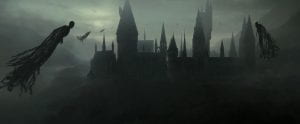Warning – I will be speaking about PTSD, grief, and death for this specific post.
Hello everyone!
In this post, I will be doing an analysis of Thestrals, what they represent, and how it can connect to the real world. Again, I am going to put a brief warning about the subject matter in this essay; I will be talking about Post Traumatic Stress Disorder (PTSD), grief, and death in this blog post. I will not call it PTSD for the remainder of this post and instead refer to it as post-traumatic stress. I am doing this to prevent a stigma against the people afflicted with this. If you aren’t comfortable reading about these subjects, please don’t worry about leaving. I may also throw in a theory for this post, also about Thestrals. I hope you enjoy it!
For those of you who don’t know, Thestrals are “black, skeletal, bat-winged horses” and are only visible to those who have “been truly touched by death” (J.K. Rowling). Harry had always thought that the carriages which took the students up to the school from the train station pulled themselves until he witnessed Cedric die at the end of his fourth year at the hands of Voldemort during the last task of the Triwizard Tournament. Harry had thought he was going crazy when he first saw them, “‘Harry is frightened by their appearance, but Luna reassures him, ‘You’re not going mad or anything. I can see them, too.’ Harry’s relief is palpable. ‘Can you?’ he says’” (Rowling).
Here is the video of Luna explaining Thestrals to Harry.
The winged horses “have a somewhat macabre reputation. In centuries past the sight of them was regarded as unlucky; they have been hunted and ill-treated for many years, their true nature (which is kindly and gentle) being widely misunderstood” (Wizarding World). The same sort of taboo could be said for people who have post-traumatic stress in our world; the “stigma around mental illness, and PTSD in particular, is strong. Stereotypes that depict people with PTSD as dangerous, unpredictable, incompetent, or to blame for their illness can promote stigma” (Julie Revelant). People who have post-traumatic stress are discriminated against and it is seen as taboo to admit to having the mental illness, in all actuality, they are just misunderstood. Thestrals are only “known as omens of misfortune and aggression” because, in order to see them, you must have seen death and there is only a stigma around mental illness because there is a lack of understanding and education (Wikia).
It took Harry multiple weeks to see the Thestrals, he had not seen them on his way to the train station on the Thestral-pulled carriages after his fourth year. It wasn’t until the start of his fifth year that Harry saw them, “even after the death of Cedric Diggory, weeks had elapsed before the full import of death’s finality was borne upon him” (Wizarding World). There are some other theories about why it took so long for Harry to see the Thestrals. Harry had seen at least three other deaths before Cedric (his mom, Quirrel, and the memory of Tom Riddle’s diary). So why had it taken him so long to see them? Here is where we get into the theory. For his parents, he doesn’t have an active memory of seeing his mom dying so that rules that one out. With Quirrel, Harry passed out before he saw the professor actually die, so that doesn’t count either. Tom Riddle’s diary doesn’t count because he is only destroying a piece of a soul and not a man or a full soul, so it isn’t really seeing death.
J.K. Rowling has said that she wrote the delay of Harry seeing the Thestrals into the books because “anyone who has suffered a bereavement knows that there is the immediate shock but that it takes a little while to appreciate fully that you will never see that person again. Until that had happened, I did not think that Harry could see the Thestrals” (Megan McCluskey). So that eliminates his parents’ deaths, Harry was too young to realize what he had so he couldn’t know what he lost. Many people were very young or weren’t even born yet when family members died; You can miss someone and know that you lost them, without actually knowing them all that well in the first place.
Here is a video about the theory.
I know this wasn’t exactly the same as my first post, I didn’t really connect the creature to mental illness, I more connected the treatment of the Thestrals in the WIzarding World to the real-world treatment of people who experience post-traumatic stress. I hope you looked at something through a new lens nonetheless! Thank you so much for reading! I hope that was entertaining, insightful, and you weren’t bored!
Sources –
Carlin, J and Ben Carlin, directors. Why Couldn’t Harry See The Thestrals? [Harry Potter Theory], SuperCarlinBrothers, 25 Feb. 2020, www.youtube.com/watch?v=CBQPZ5JvN58
Lesperance, Alice. “Living Through Death With Harry Potter.” The Atlantic, Atlantic Media Company, 23 Jan. 2018, www.theatlantic.com/entertainment/archive/2018/01/living-through-death-with-harry-potter/550445/
McCluskey, Megan. “Harry Potter Plot Holes and Questions Explained.” Time, Time, 20 Nov. 2017, www.time.com/4999597/harry-potter-plot-holes-explained/
Revelant, Julie, et al. “PTSD Stigma: Why It Exists and What We Can Do About It: Everyday Health.” EverydayHealth.com, 17 Apr. 2018, www.everydayhealth.com/ptsd/ptsd-stigma/
Rowling, J.K. “Thestrals.” Wizarding World, Wizarding World Digital, 2 Oct. 2019, www.wizardingworld.com/writing-by-jk-rowling/thestrals
“Thestral.” Harry Potter Wiki, harrypotter.fandom.com/wiki/Thestral www.harrypotter.fandom.com/wiki/Thestral
Yates, David, director. Thestrals – Harry Potter and the Order of the Phoenix [HD]. Harry Potter and the Order of the Phoenix, 15 Aug. 2012, www.youtube.com/watch?v=C7Cyyb0jk7Q
